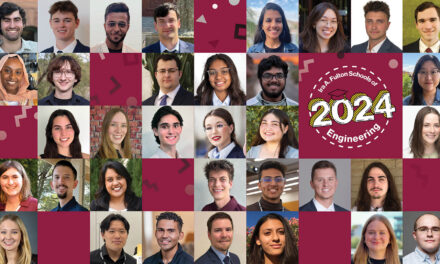
Undergraduate research ignited Sisson’s passion for engineering

Electrical engineer Ja’Lon Sisson took full advantage of undergraduate research programs to make his education the best that it could be. Photographer: David E. Talbert
Recent graduate is headed to Duke University on fellowship
Sometimes life reveals itself not in huge moments, but instead in smaller marks that make us who we are.
For Ja’Lon Sisson it was a fork in the road that many college students come upon. The work becomes difficult, there are a lot of distractions. They are faced with the question. “Do I have what it takes and can I make the sacrifices needed to achieve my goal?” For Sisson, the answer was a resounding, “Yes.”
Halfway through his academic career in the Ira A. Fulton Schools of Engineering, the aspiring electrical engineer found himself on academic probation. Working 30 hours a week at FedEx to pay his bills, he struggled to find the time necessary to do his school work.
Coming “close to the edge” was a wake up call, informed by an experience in his home state of Nevada.
“I was interning at Nellis Air Force Base during the summer. I got to see the day-to-day operations of actual engineers, see how what I has learning in school could be applied to problems, finding solutions and things of that nature. I said to myself, ‘I want this.’ And I never looked back,” Sisson said.
And in that moment he made a choice. He quit his job, took out student loans and launched himself full-force into his education and research.
Sisson, a newly minted Arizona State University graduate with a bachelor’s degree in electrical engineering, remembers wanting to be an engineer from the age of three or four. Like many young boys, he loved computers and video games.
“I loved to take things apart and put them back together,” he said.
He also wanted to work for NASA. He learned that ASU had a NASA Space Grant Program and he applied in 2014. He was accepted.
Under the mentorship of Daniel Bliss, associate professor in the School of Electrical, Computer and Energy Engineering, Sisson became a researcher. He worked on the simulation and design of radar systems within MATLAB, a tool for numerical computation and visualization. The initial simulated prototype was a mono-static radar that identified fixed targets, which was further developed into a bi-static model that actively tracked moving targets.
Sisson presented his work at the Space Grant Symposium the last semester of his senior year, he says proudly.
He also became involved in a National Science Foundation renewable energy project with professor George Karady. ASU is a partner on the FREEDM (Future Renewable Electrical Energy Delivery and Management) Systems Engineering Research Center, and Sisson’s research focused on systems for protecting the smart energy grid from faults.
Lastly, his capstone project (watch video log) for his senior year focused on near field communications, or NFC, and how secure these systems are. Using Apple Pay on an iPhone to make a financial transaction is an example of NFC.
“I enjoyed so much working on that project with my friends. I loved being in the lab and getting my hands dirty,” said Sisson. “I also liked learning to give presentations to communicate why the research matters.”
The young engineer, who said he never doubted his ability even when times got tough, is now headed to graduate School at Duke University on a GEM fellowship through the National Consortium for Graduate Degrees for Minorities in Engineering and Science. Intel, where he is working this summer, is his industry sponsor.
As for the future, Sisson is not sure what the long-term plan may be.
“I still don’t know enough. I want to find out what I love, and I am hopeful graduate school will help me find that,” he said.
Media Contact
Sharon Keeler, [email protected]
480-727-5618
Ira A. Fulton Schools of Engineering






































